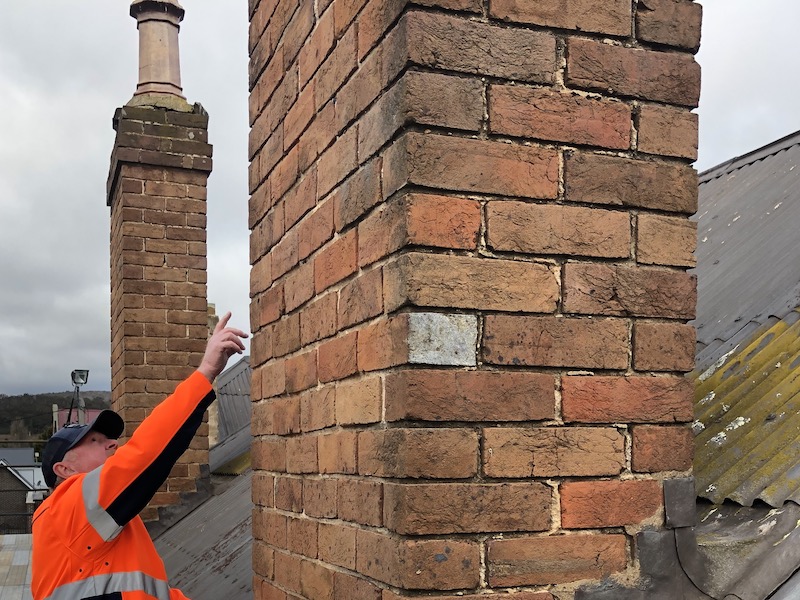
Owen Carragher with a fan that was installed under the floor at historic St Clair to help air circulation. Photo: Sarah Ruberto.
A specialist restorer of heritage buildings who has stopped many decades of damaging rising damp at historical St Clair in Goulburn hopes a final treatment of lime mortar can finish the intricate job.
Owen Carragher says new foundations, an electric pump, poultice and traditional lime mortar that allows a wall to breath are among measures to ensure Goulburn’s second-oldest home remains standing for at least another 50 to 100 years.
His team and skilled subcontractors have removed asbestos and repaired roofing, guttering, brickwork, timber work and glass. They have installed a steel balcony, fitted out bathrooms and the kitchen, replaced flooring, painted, tiled and rewired the 1840s dwelling and coach house.
Tenacious and exacting, Owen is loathe to walk away from St Clair until the crucial lime mortar plastering is finished. That work awaits Goulburn Mulwaree Council’s decision on more funding following the completion of the $1 million-plus restoration project.
Owen learned his trade from his father, Irish carpenter and joiner Frank Carragher, who was one of the last traditional journeyman in his craft. In Frank’s day, before a tradesman was licensed he had to spend three months at a time working with other qualified tradesmen such as plasterers and stonemasons to learn how his skills interacted with theirs.

St Clair villa in Goulburn. Photo: Supplied.
By the time he had completed his training, Frank – who hailed from the fishing village of Kilkeel in Country Down – became a pernickety craftsman. The National Trust often engaged Frank to restore stately old homes and centuries-old castles. Along the way, he passed on his skills to Owen.
“I always try to leave a job right for the next person coming,” says Owen. “Whatever I do I am aware of the painter or plasterer coming behind me so all my joints are nice and neat, stuff like that. In the modern days, it’s slap it up, let the other fella worry about it.”
Owen has seen plenty of challenging damp problems in buildings.
“I was born in a bucket,” he says with a smile, referring to his Irish origins.
However, Owen says he cannot stop water from getting in a hole, like the one in which St Clair sits, in Sloane Street.
“In one room we dug it out to the same depth of every other room and dug deeper to put a sump pit in and a pump with a switch so if there is adverse weather, at least there is some protection there to pump it out,” he says.
While Owen’s team has stopped the dampness, some remains locked in the walls, where it has been accumulating for many years. All the plaster has to come off and a poultice applied to extract the salts, which will break down bricks if left unattended.
Reapplying the plaster in such circumstances almost always leads to mistakes with hard-set mortars which don’t allow a wall to breathe. Owen has a colleague from Sydney, originally from Ireland, who knows how to solve the problem with a lime mortar finish.

Owen Carragher inspecting brickwork on the roof of St Clair in Goulburn. Photo: Sarah Ruberto.
“That is what I am looking forward to if we can get the money to finish so I can walk away and say I know the job will be right, that the money council put into this building is well founded and it will last for another 50 to 100 years,” he says.
“I’m proud of the work we have done so far. That final piece will be the icing on the cake because I’ll know then that it is fixed properly.”
As difficult as the St Clair job has been, it is the type of work that appeals to Owen.
“I get a little bit of a kick from the fact most other builders run away from a job like that,” he says. “My plan to do the work and the way I did it worked.”
Owen’s railway station restoration for the Australian Rail Track Corporation includes whistlestop places such as Ariah Park, Molong, Bungendore loading dock and Crookwell goods shed, to name a few.
His team replaced a slate roof on top of Lithgow’s sandstone station.
A diagnosis of cancer of the bladder caused Owen to relocate to Goulburn with his family. He first went to Big Hill, near Marulan, where he built an impressive new home offering luxury guest accommodation, before settling in the heritage city with his family.
His cancer prognosis is good, and his unique skills are still highly sought after.
Original Article published by John Thistleton on The RiotACT.











